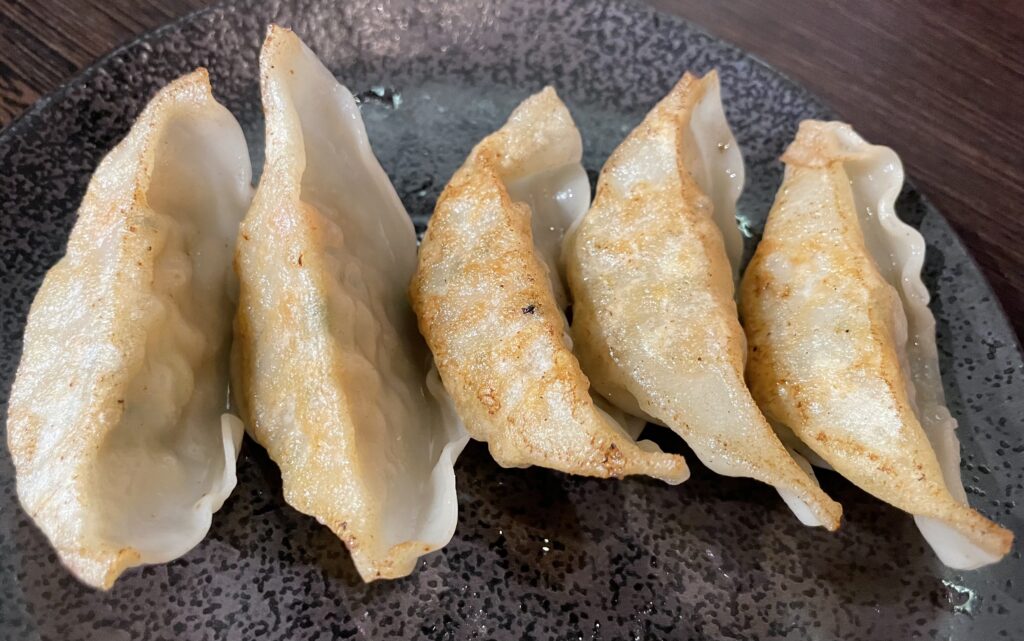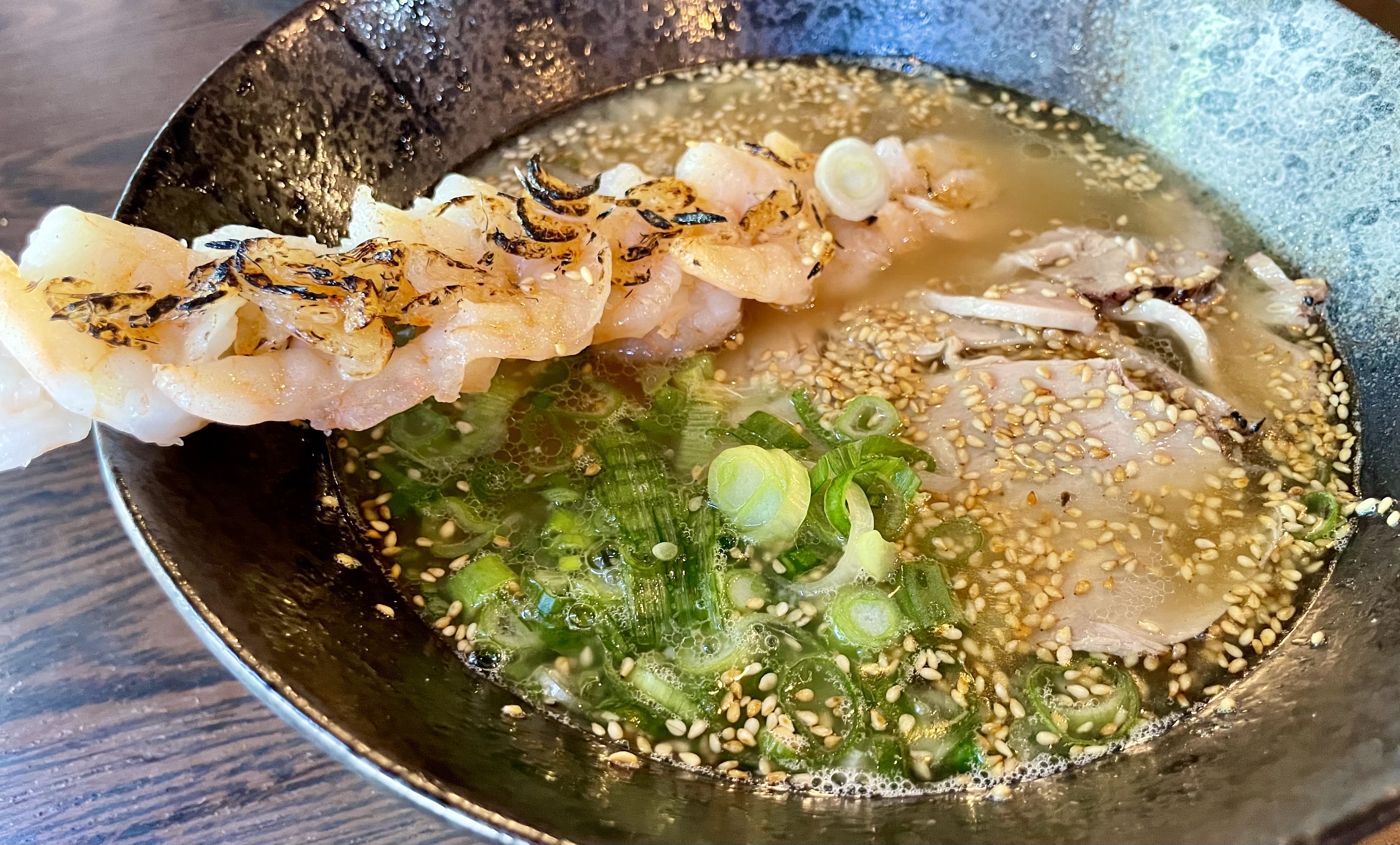Welcome to another food adventure in Frankfurt. Today, we’re thrilled to introduce you to a relatively new spot – an authentic Japanese ramen place that’s won our hearts right from the start. We first discovered this cozy eatery just weeks after it opened. Back then, the menu was modest, with only three ramen soup bases.
Despite the limited options, we kept coming back again and again. What we experienced there is the spirit of craftsmanship, typical of the Japanese fashion – focusing on a few dishes but perfecting each one with care and dedication. Simple, yet exceptional, the hallmark of Japanese cuisine that we deeply admire.
Now, to our delight, their menu has expanded, offering more appetizers and new ramen soup bases. Of course, we couldn’t wait to try them, and as always, we were not disappointed. So get ready, as we share our favorites from this humble yet extraordinary Japanese ramen restaurant.
Restaurant Profile
- Name of the Restaurant: Nana’s Ramen
- Adress: Mainzer Landstraße 125, 60327 Frankfurt am Main
- Style: Japanese Cuisine
- Price: around 20 – 30 EUR per Person (incl. drinks and tips)
The first appetizer is vegetarian – Edamame Harumaki, a Japanese spring roll filled with a mix of bell peppers, glass noodles, and lettuce.

The wrappers have a natural green hue, thanks to the addition of edamame in the dough, which gives it a gentle, sweet, vegetal taste. This flavor goes well with the crisp lettuce, sweet bell pepper, and soft glass noodles, creating a refreshing and crunchy mouthfeel. Paired with yuzu chili sauce, it brings a very delightful balance of citrus brightness, a bit of heat and a touch of bitterness, making it a great complement to the fresh flavors of the roll.
Next up is a classic Japanese favorite – gyoza. These dumplings are filled with a savory mix of minced meat, carrots, cabbage, corn and shallots, all wrapped in an incredibly thin skin.

Expertly pan-fried, the gyoza is golden brown and crispy on one side, while the other side remains tender and soft. Thanks to the thin skin, it requires less cooking time and absorbs minimal oil, keeping the dumplings light and letting the juicy, flavorful filling take the spotlight – the minced meat forms rich, hearty base, while the carrots and corn add a natural sweetness. They are nicely balanced by the crisp, fresh cabbage and pungent shallots, creating a satisfying taste in every bite.
Paired with a dipping sauce of rice vinegar and chili oil, the tangy and spicy kick elevates the flavors to new heights.

Katsuretsu, or “Katsu with Fillings” is a popular Japanese dish of breaded and fried cutlets with different fillings. Each of the four pieces has a golden, crisp exterior. Two are filled with sweet corn paste, delivering a burst of natural sweetness and a pleasing soft texture against the crunchy breading. The other two are filled with a green paste of vegetables and herbs, and adorned with black sesame seeds. This filling provides a savory and aromatic contrast to the corn-filled pieces.

Accompanying these cutlets are shredded cabbage stripes, a refreshing palate cleanser between bites of fried foods.
To add moisture and flavor, dip the katsuretsu into tonkatsu sauce. The sauce has a complex, savory-sweet taste – slightly peppery, mildly sour, and subtly spicy. It pairs well with the fried crispness and enhances the flavors of the fillings.
Tsukune Cheese is a favorite at izakayas (Japanese pubs) and restaurants, and it’s one of our most frequent orders. This dish consists of Japanese-style meatballs (known as “tsukune”) grilled with melted cheese on top.

The meatballs are firm, savory and well-seasoned, with a tantalizing blend of soy sauce, garlic, ginger, and a hint of sweetness. The cheese topping, when grilled, gets slightly charred and smoky on top. It looks so appetizing and adds a creamy richness to the savory meatballs.
This dish is served with a sweet soy-based sauce, likely a mix of teriyaki and dashi (Japanese soup stock) that offers a balanced fusion of sweetness, saltiness and umami. It certainly adds an aromatic depth and boosts its hearty, luscious appeal.
At Nana’s Ramen, they offer different noodle types to cater to different tastes. Each soup base is paired with the noodle type that best complements its flavor. The thin noodles are delicate and smooth, while the thick noodles are hearty and a bit chewy.
In addition to standard toppings, Nana’s Ramen now offers numerus customization options at extra costs. You can add extra noodles, pork, chicken slices, or minced meat. They also offer an array of toppings, such as tsukune (three savory meatballs), shrimp, eggs, extra chili, and a variety of vegetables like eggplant, zucchini, corn, tofu, and more. So you can tailor your bowl to your exact liking.
The specialty of Nana’s Ramen is undoubtedly the Tori Paitan (鶏白湯, which translates to “chicken white soup“).
Tori Paitan is a beloved classic ramen broth, celebrated for its luscious, creamy white soup and deep, flavorful taste. Its popularity in Japan dates back to the early 20th century. During this time, Japanese chefs began experimenting with ways to fully extract the deliciousness of chicken. Through continuous experimentation and refinement, Tori Paitan gradually emerged as a distinctive ramen feature and has become a vital part of Japanese ramen culture.

Tori Paitan is made by simmering chicken and chicken bones for a long period, allowing collagen and fat to dissolve into the broth, giving it its signature creamy white color and thick consistency. During the simmering, seasonings like sault and soy sauce are added to enhance the flavors.
The result is a delicious broth that’s not only rich in flavor but also packed with protein, collagen, and various nutrients that are beneficial to health.
The Nōkō Shōyu Tori Paitan Ramen (濃厚醤油鶏白湯ラーメン or „Rich Soy Sauce Chicken White Soup Ramen” in English) at Nana’s Ramen offers a gratifying dive into the culinary artistry of Japanese paitan. The creamy white broth has a form-like consistency on top, crafted from hours of vigorous boiling and emulsification of chicken bones. The broth is thick, luscious and umami-rich, sprinkled with sesame seeds for a nutty crunch, and topped with tender chashu pork, tangy red ginger, crisp bean sprouts, and fresh green onions.

When the silky, smooth noodles are enveloped in the rich broth, each slurp unveils a satisfying depth of flavors. Eat with various toppings for a dynamic mouthfeel – red ginger for a pungent kick, bean sprouts for a fresh crunch, and green onions for a subtle sharpness. The chashu pork slices, braised to a fine tenderness, brings a savory heartiness, wonderfully complementing this deep umami dish.

Miso Tori Paitan Ramen (味噌鶏白湯ラーメン or “Miso Chicken White Soup Ramen” in English) is a delectable ramen dish that combines the rich, creamy texture of chicken paitan broth with the savory depth of miso. It’s topped with sweet corn, aromatic shallots, and flavorful minced meat, all brought together in a luxurious paitan broth.


The broth boasts a pronounced umami-ness from the miso and a satisfying saltiness that complements each ingredient beautifully. The noodles are thick and slightly chewy. Its firm texture is perfect for soaking up the rich broth, making every mouthful packed with flavor. Pair with sweet corn and the pungent shallots that balance the hearty minced meat and the rich, creamy broth. It’s a great choice for those who love rich and savory flavors.
However, due to miso’s inherent saltiness, the soup is best enjoyed in moderation to avoid excessive thirst. If you’re sensitive to salt or prefer a lighter experience, it’s a good idea to sip the broth sparingly rather than drink it in large quantities.
Ebi Shio Ramen (海老塩ラーメン or “Shrimp Salt Ramen” in English) is a delicious ramen dish known for its clear and light broth, different from the richer paitan soups. The broth, with its shio (“salt” in Japanese) base, has a clean, savory taste. It’s seasoned with shirasu, small dried, salted shrimps, which lend a briny, umami flavor.

Standard toppings include green onions, spring sprouts, and a grilled shrimp skewer. We customized it with extras like chashu pork and chili paste, which add a delicious tenderness and a spicy kick. The thin, slightly firm noodles are ideal for the shio broth, allowing the broth’s delicate flavors to come though without overpowering it.
The spotlight of this dish is the grilled shrimps, with their tender and smoky flavor. The shirasu and garlic on top are slightly charred, imparting a subtle burnt taste and a layer of garlicky, umami goodness, nicely contrasting against the light broth. We asked for extra chili paste (level 2, the spicier option available) in a separate dipping bowl to adjust the spice level in our broth and enjoy dipping the grilled shrimp. The fiery addition perfectly complements the shrimp’s natural sweetness, making each morsel all the more dynamic and invigorating!

The introduction of ramen to Japan dates back to 1912 when it arrived in Yokohama with returning Japanese travelers from China. This exchange was facilitated by the Treaty of Amity and Commerce between Japan and Qing China in 1871, which spurred Chinese migration and the establishment of Chinatowns in major ports like Yokohama, Kobe, and Nagasaki. One of the earliest ramen shops in Japan catering to these communities, “Rairaiken,” opened in Asakusa, Tokyo, in 1910.
While ramen has its roots in China, it has been considerably evolved and popularized in Japan. Unique variations include soy sauce, salt, miso flavors, and chicken paitan which we explored today. At Nana’s Ramen, you can also try spicy broths like Tantanmen (特製担々ラーメン) with chili pepper.
Additionally, there’re vinegary broths reminiscent of soba, European-style tomato broths, and even curry flavors. One of the most beloved styles is tonkotsu, originating from Kyushu, known for its rich, creamy pork bone broth. There’s much more to discover in the world of Japanese ramen, and Nana’s Ramen is a great place to start. Join us as we continue our delicious explorations – stay tuned for more!




